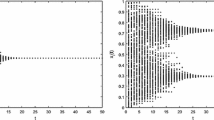Abstract
We use a model of opinion formation to study the consequences of some mechanisms attempting to enforce the right behaviour in a society. We start from a model where the possible choices are not equivalent (such is the case when the agents decide to comply or not with a law) and where an imitation mechanism allow the agents to change their behaviour based on the influence of a group of partners. In addition, we consider the existence of two social constraints: (a) an external authority, called monitor, that imposes the correct behaviour with infinite persuasion and (b) an educated group of agents that act upon their fellows but never change their own opinion, i.e., they exhibit infinite adamancy. We determine the minimum number of monitors to induce an effective change in the behaviour of the social group, and the size of the educated group that produces the same effect. Also, we compare the results for the cases of random social interactions and agents placed on a network. We have verified that a small number of monitors are enough to change the behaviour of the society. This also happens with a relatively small educated group in the case of random interactions.
Similar content being viewed by others
References
R. Axelrod, The Complexity of Cooperation (Princeton University Press, Princeton, 1997)
S. Galam, Y. Gefen, Y. Shapir, J. Math. Sociol. 9, 1 (1982)
S. Galam, J. Math. Psychol. 30, 426 (1986)
S. Galam, Int. J. Modern Phys. C 19, 409 (2008)
C. Castellano, S. Fortunato, V. Loreto, Rev. Mod. Phys. 81, 591 (2009)
V. Semeshenko, Interacting learning agents: Models, Simulations and Experiments (VDM Verlag, Berlin, 2009)
M. Mobilia, Phys. Rev. Lett. 91, 028701 (2003)
M. Mobilia, A. Petersen, S. Redner, J. Stat. Mech. P0802 (2007)
R. Lambiotte, S. Redner, Europhys. Lett. 82, 18007 (2008)
S. Galam, S. Moscovici, Eur. J. Soc. Psychol. 21, 49 (1991)
S. Galam, Physica A 238, 66 (1997)
M.F. Laguna, G. Abramson, S. Risau-Gusman, J.R. Iglesias, J. Stat. Mech. P03028 (2010)
J.-P. Nadal, D. Phan, M.B. Gordon, J. Vannimenus, Quant. Finance 5, 557 (2005)
M.F. Laguna, S. Risau Gusman, G. Abramson, S. Gonçalves, J.R. Iglesias, Physica A 351, 580 (2005)
B. Lantané, Am. Psychol. 36, 343 (1981)
M.F. Laguna, G. Abramson, D.H. Zanette, Complexity 9, 31 (2004)
S. Galam, F. Jacobs, Physica A 381, 366 (2007)
M. Porfiri, E.M. Bollt, D.J. Stilwell, Eur. Phys. J. B 57, 481 (2007)
M.B. Gordon, J.R. Iglesias, V. Semeshenko, J.P. Nadal, Eur. Phys. J. B 68, 133 (2009)
K. Kacperski, J.A. Holyst, Physica A 287, 631 (2000)
S. Galam, Physica A 389, 3619 (2010)
A. Grabowski, R.A. Kosinski, Physica A 361, 651 (2006)
D.J. Watts, S.H. Strogatz, Nature 393, 440 (1998)
S.H. Strogatz, Nature 410, 268 (2001)
M.E.J. Newman, Soc. Ind. Appl. Math. Rev. 45, 167 (2003)
R. Albert, A.-L. Barabási, Rev. Mod. Phys. 74, 47 (2002)
S. Harrendorf, M. Heiskanen, S. Malby, International Statistics on Crime and Justice, European Institute for Crime Prevention and Control, Affiliated with the United Nations, Helsinki, 2010, http://www.unodc.org/documents/data-and-analysis/Crime-statistics/International˙Statistics˙on˙Crime˙and˙Justice.pdf
M. Gonzatto, Reforço no número de agentes e equipamentos faz EPTC multar 40% a mais na Capital, Zero Hora on-line (2012-03-28), http://zerohora.clicrbs.com.br/rs/geral/transito/noticia/2012/03/reforco-no-numero-de-agentes-e-equipamentos-faz-eptc-multar-40-a-mais-na-capital-3708971.html
L. Viano, Hay más policías, pero más delitos, La Voz on line (2011-07-30), http://www.lavoz.com.ar/ciudadanos/hay-mas-policias-pero-mas-delitos
Author information
Authors and Affiliations
Corresponding authors
Rights and permissions
About this article
Cite this article
Fabiana Laguna, M., Abramson, G. & Iglesias, J.R. Compelled to do the right thing. Eur. Phys. J. B 86, 202 (2013). https://doi.org/10.1140/epjb/e2013-30783-2
Received:
Revised:
Published:
DOI: https://doi.org/10.1140/epjb/e2013-30783-2




